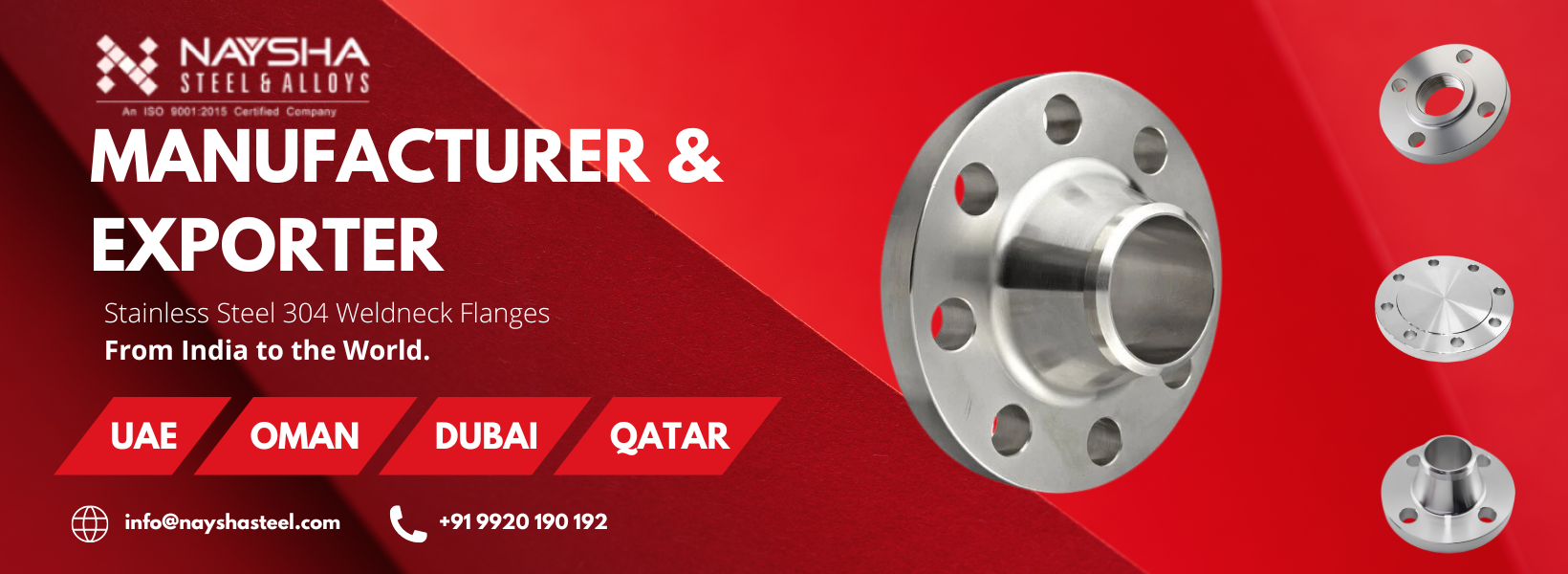Types of Stainless Steel SS 304 Flanges in Mumbai, India
In the realm of piping systems, Stainless Steel 304 flanges emerge as stalwart components, offering unparalleled durability and versatility.Their significance spans across various industries, from chemical processing to food and beverage.Delving into the diverse range of Stainless Steel 304 flanges unveils a spectrum of choices tailored to specific needs and applications. Let's embark on an exploration of these variants:Let's embark on an exploration of these variants:

Weld Neck Flanges for Stainless Steel SS 304:
Advantages
Exceptional stability and strength due to the welded connection with the pipe.
Gradual tapering design ensures even stress distribution, ideal for high-pressure and high-temperature applications.
Disadvantages
Requires skilled welding for installation, increasing labor costs.
Longer lead times compared to other flange types.
Specifications
Chemical Composition:
- Chromium (Cr): 18-20%
- Nickel (Ni): 8-10.5%
- Carbon (C): 0.08% max
Mechanical Properties:
- Tensile Strength: 515 MPa (minimum)
- Yield Strength: 205 MPa (minimum)
FAQs
Q: Can weld neck flanges be used in applications with fluctuating temperatures?
A: Yes, their design ensures stability even under thermal expansion and contraction.
Slip-On Flanges in Stainless Steel SS 304
Advantages
Easy alignment and installation, reducing labor costs.
Suitable for low-pressure applications in water treatment and HVAC systems.
Disadvantages
Lower strength compared to weld neck flanges, limiting use in high-pressure environments.
Vulnerable to corrosion at the welded connection.
Specifications
Chemical Composition: Same as above (Stainless Steel 304)
Mechanical Properties: Same as above
FAQs
Q: Are slip-on flanges suitable for applications with frequent disassembly?
A: Yes, their design facilitates easy removal and reinstallation.
Socket Weld Flanges with Stainless Steel 304(SS 304)
Advantages
Precise fit and weld, ensuring leak-free connections.
Ideal for moderate-pressure applications with smaller pipe sizes.
Disadvantages
Limited availability in larger sizes.
Susceptible to stress corrosion cracking in harsh environments.
Specifications
Chemical Composition: Same as above (Stainless Steel 304)
Mechanical Properties: Same as above
FAQs
Q: Can socket weld flanges be used in applications with high vibration?
A: It's not recommended as the welded connection may weaken under prolonged vibration.
Threaded Flanges of Stainless Steel 304/SS 304L/SS 304H
Advantages
No welding required, facilitating easy installation and removal.
Suitable for low-pressure applications where occasional disassembly is necessary.
Disadvantages
Prone to leakage at the threaded connection if not properly sealed.
Limited to low-pressure applications due to the threaded connection.
Specifications
Chemical Composition: Same as above (Stainless Steel 304)
Mechanical Properties: Same as above
FAQs
Q: Can threaded flanges be used in applications with high temperatures?
A: Yes, but caution must be exercised to ensure proper sealing and prevent leakage.
Blind Flanges Crafted from Stainless Steel 304
Advantages
Provides a secure seal, ideal for pressure testing and isolation.
Prevents debris accumulation in piping systems.
Disadvantages
Lacks versatility for connection points.
Not suitable for applications requiring frequent access to the pipeline.
Specifications
Chemical Composition: Same as above (Stainless Steel 304)
Mechanical Properties: Same as above
FAQs
Q: Can blind flanges be used in applications with corrosive fluids?
A: Yes, but proper material selection and sealing are crucial to prevent corrosion.
Conclusion:
Stainless Steel 304 flanges offer a wide array of options catering to diverse industrial needs. Each type possesses distinct advantages and disadvantages, enabling informed decision-making based on specific application requirements. Whether it's the robustness of weld neck flanges or the ease of installation with slip-on flanges, Stainless Steel 304 proves to be a reliable choice for critical piping systems. Understanding the nuances of each flange type empowers industries to optimize performance, ensuring seamless operations and enhanced reliability in their infrastructure.

